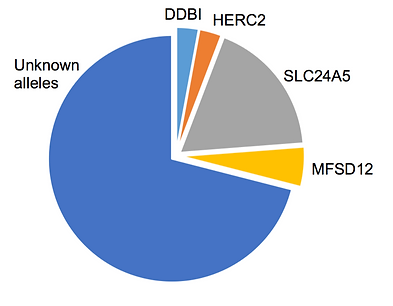Quantitative Data
Skin Pigmentation Genes
With this assignment, I aimed to translate quantitative data in into another visual form that is easily understood. I chose to interpret a graph from Sarah Tishkoff’s study published in October 2017, “Loci associated with skin pigmentation identified in African populations.”
This graph is a Manhattan plot, named after its resemblance to the Manhattan skyline. I chose to translate this data into a pie chart to simplify the genetic information of the Manhattan plot. Pie charts are extremely simplified, but also intuitive and familiar. People (other than geneticists) might see this complicated Manhattan plot in a science magazine and be too intimidated to understand it’s meaning. In the field of genetics, Manhattan plots are widely used—even as a map that marks the location of these alleles.
Manhattan plots convey two pieces of information to geneticists:
-
The location of a SNP (single nucleotide polymorphism) on a chromosome—the numbers along the x-axis represent the 23 chromosomes
-
The amount of influence the SNP has on some trait represented by the peak height (y-axis) in the genome.
Although Manhattan plots are efficient tools to scientists, this information just isn’t relevant to the rest of us. The pie chart, however, helps us grasp the concept of gene expression without stumbling over an unfamiliar graph. For example, the grey slice, or our SNP named “SLC24A5,” contributes the most to skin pigmentation of the four genes discovered. In the Manhattan plot, it’s the SNP with the tallest peak. Each pie slice visualizes each alleles sizable contribution to skin pigmentation. It also shows just how significant the findings of this study are in piecing together the map of the human genome.
This study is considered very successful in the scientific world as it provided substantial evidence may debunk preconceived notions of the complexion of ancient humans. As seen in the pie chart, this study alone identified practically ⅓ of the genes responsible for skin pigmentation, and have existed in all humans since 900,000 years ago.


